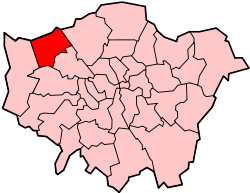Stanmore
Stanmore is a residential area and district in the London Borough of Harrow in Greater London. It is centred 11 miles (18 km) northwest of Charing Cross. The area, based on the ancient parish of Great Stanmore includes southern slopes of the unnamed ridge of hills rising to Stanmore Hill, one of the highest points of London, 152 metres (499 ft) high. The population of the appropriate London Borough of Harrow Ward (Stanmore Park) was 11,229 at the 2011 Census.[1] The Canons ward which covers Stanmore railway station and eastern areas had a population of 12,471 at the same census.[2]
| Stanmore | |
|---|---|
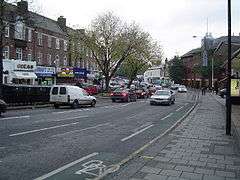 Stanmore Broadway | |
 Stanmore Location within Greater London | |
| Population | 23,700 (Stanmore Park and Canons wards 2011) |
| OS grid reference | TQ1691 |
| London borough | |
| Ceremonial county | Greater London |
| Region | |
| Country | England |
| Sovereign state | United Kingdom |
| Post town | STANMORE |
| Postcode district | HA7 |
| Dialling code | 020 |
| Police | Metropolitan |
| Fire | London |
| Ambulance | London |
| UK Parliament | |
| London Assembly | |
Toponymy
The area was recorded in the Domesday Book as Stanmere, the name deriving from the Old English stan, 'stony' and mere, 'a pool'. There are outcrops of gravel on the clay soil here and the mere may have been one of the ponds which still exist. By 1574 the area had become known as Great Stanmore to distinguish it from Little Stanmore.
History
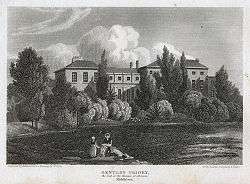
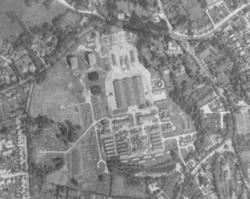
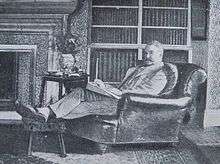
Until the late 19th century, Stanmore was a small rural community. In the Middle Ages, a monastic community of cell of Augustinian Canons was established at Bentley Priory. It was dissolved in 1536 during the Dissolution of the Monasteries.[3]
In 1729 Andrew Drummond, the founder of the Drummonds Bank and Jacobite sympathiser, purchased Stanmore House and the Stanmore Park estate as his country residence.[4][5] A new mansion was built for Andrew Drummond at Stanmore Park in 1763: it was designed in neo Palladian style by John Vardy and Sir William Chambers. Zoffany painted the Drummond family in the grounds. The Drummonds leased Stanmore House to the Countess of Aylesford (in 1815) and later to Lord Castlereagh. The Marquess of Abercorn acquired the estate, along with Bentley Priory, in 1839. In 1848, Stanmore House was sold again to George Glyn, 1st Baron Wolverton. The house was later used as a boys' preparatory school. It was demolished in 1938 and the site was taken over by the Royal Auxiliary Air Force as the headquarters of Balloon Command.[6] The history of the area is reflected in street names, such as Lady Aylesford Avenue and Abercorn Road. RAF Stanmore Park closed in 1997 and is now a housing estate.
The wealthy businessman James Duberley commissioned Sir John Soane to design a large mansion house north of the original Bentley Priory in 1775. This house was added to throughout the eighteenth and nineteenth centuries by various owners. It was significantly extended in 1788, again by Sir John Soane, for John Hamilton, 1st Marquess of Abercorn. The Priory was the final home of the Dowager Queen Adelaide, queen consort of William IV, before her death there in 1849. In 1882 Bentley Priory was acquired by the hotel millionaire Frederick Gordon, who turned it into a country house hotel for wealthy guests.[5][3]
The railways first reached Stanmore in 1890 when Frederick Gordon opened the Stanmore branch line to improve access to Bentley, in the hope of attracting more affluent customers. Great Stanmore Parish Council stipulated that Gordon's new station building should be of the highest quality, and so Stanmore station (later renamed Stanmore Village) was designed to resemble a small English church, complete with a spire and gargoyles. Trains were run by the London and North Western Railway (LNWR). Gordon also purchased land near the station and laid out a wide avenue—named Gordon Avenue—lined with new superior houses, in the hope of attracting wealthy Londoners to come to live in the country and commute into the city on his new railway. Despite his efforts, Gordon's business ventures at Stanmore were not successful, and in 1899 he sold the railway to the LNWR.[7] Gordon died in 1904 at his Hotel Metropole in Cannes. His body was brought back to Stanmore and buried in the family grave at the church of St. John's Church.[7]
In the early years of the 20th century, as the population of London grew, Stanmore was affected by increasing urbanisation and the small rural village was rapidly becoming a suburb of London. In December 1932 the Metropolitan Railway (MR) opened a new electric railway with a station at Stanmore (now the London Underground station on the Jubilee line). This rapid, direct route into London presented strong competition for Gordon's old railway (by now run by the London, Midland and Scottish Railway (LMS)), especially as branch line passengers had to change trains at Harrow & Wealdstone for London services. After years of decline, Stanmore Village station was closed by British Railways in 1952.[7]
The opera librettist W. S. Gilbert (of the Gilbert and Sullivan duo) lived at Grim's Dyke, a country house located between Stanmore and Harrow Weald. In 1911, Gilbert drowned in the pond at Grim's Dyke. He was cremated at Golders Green and his ashes buried at the churchyard of St. John's Church, Stanmore.[8]
During World War II, Stanmore played an important role. Stanmore had an outstation from the Bletchley Park codebreaking establishment, where some of the Bombes used to decode German Enigma messages were housed. Bentley Priory was taken over by the RAF, and in 1940 the Battle of Britain was controlled from RAF Bentley Priory. RAF Bentley Priory closed in 2009.[9]
Parish church
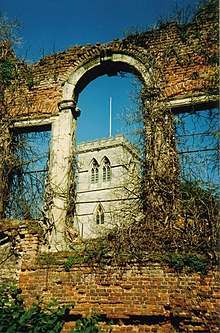
The first parish church was the 14th-century St Mary's, built on the site of a wooden Saxon church, which itself may have been built on the site of a Roman compitum shrine.[10][11] It has now completely disappeared; one tomb survives in a back garden.[10][12]
This building was replaced by a new one built in the current churchyard, consecrated in 1632 and dedicated to St. John the Evangelist.[10][11] Built of brick and consecrated by Archbishop Laud, it is one of the relatively small number of churches built in Britain between the medieval period and the eighteenth century.[10] By the nineteenth century, this church had become considered outdated and unsafe. After its replacement, its roof was pulled off and it became a ruin.
A new church was constructed in the Gothic Revival style from 1849–50. Queen Adelaide's last public appearance was to lay the foundation stone of the new church. She gave the font and when the church was completed after her death, the east window was dedicated to her memory.[13]
Modern Stanmore
The suburb is characterised by numerous small restaurants and cafés, several public houses and many unique shops, such as a natural health store and boutique-style clothing stores. The centre of Stanmore is dominated by the presence of large Sainsbury's and Lidl supermarkets. There are also eateries, such as Prezzo and Costa Coffee, in the centre of the town. Stanmore's extensive residential areas are mainly leafy and predominantly affluent, with many residents commuting daily to jobs in central London.
The public amenity of Stanmore Park is at the foot of Stanmore Hill and right next to the local library. This is the only outdoor leisure field in the area. A nursery has recently been added and was expected to begin function in late 2019.
On the border with Bushey is Stanmore Cricket Club, one of the oldest in the Middlesex county championship league, which celebrated 150 years in 2003 and is still successful at present. The club has nurtured two famous cricketers who have played tests for England in the last two decades: Angus Fraser and Mark Ramprakash.
Stanmore is home to Avanti House Primary and Secondary Schools, Park High School and Bentley Wood High School, Stanmore College (a government further education establishment) and a local library run by the London Borough of Harrow. North London Collegiate School, one of the UK's top public schools for girls, is in Stanmore. The suburb also hosts the Royal National Orthopaedic Hospital – known as RNOH – which is famed for its spinal unit and paediatric/young adult hip unit.
Demography
Stanmore has Christian, Shia Muslim, Hindu, Jain, Jewish and Catholic communities, including its local synagogue, Stanmore and Canons Park Synagogue on London Road (which has one of the largest memberships of any single synagogue in Europe and the second largest in the UK behind Borehamwood),[14] an Islamic centre, KSIMC of London (Hujjat)[15] and a new Hindu temple[16] on Wood Lane.
The 2011 census showed that in Stanmore Park ward, 56% of the population was white (47% British, 7% Other, 2% Irish) and 20% Indian. 31% was Christian, 22% Jewish, 15% Hindu and 11% Muslim.[17] Canons ward (covering eastern areas) was 52% white (40% British, 10% Other, 2% Irish) and 24% Indian. 26% was Christian, 25% Jewish, 18% Hindu and 11% Muslim.[2]
Notable natives and residents
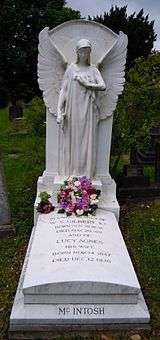
- Queen Adelaide (1792–1849), queen consort of William IV, lived at Bentley Priory, Stanmore from 1848 until death
- George Hamilton-Gordon, 4th Earl of Aberdeen, Peelite Prime Minister (in office December 1852 – February 1855); was raised and is buried in Stanmore
- Frederick Gordon, hotel millionaire and builder of the first Stanmore railway
- W. S. Gilbert, English dramatist, librettist and illustrator; lived at Grim's Dyke and died in the lake there. Ashes buried in Stanmore.
- Robert and Ellen Hollond lived here. He was a balloonist and MP, she founded London's first créche.[18]
- Clement Attlee, Labour Prime Minister in the first post-war government; lived in a large villa "Heywood", later replaced by mid rise apartments
- Chaz Jankel, singer and multi-instrumentalist, was born in Stanmore
- Billy Idol, rock musician, was born in Stanmore
- Dave Bassett, football coach, was born in Stanmore
- Clive Anderson, radio and television presenter, was born in Stanmore
- Peter Van Hooke, drummer, was raised in Stanmore
- Linda Hayden, actress, was born in Stanmore
- Anthony Horowitz, screenwriter and author, was born in Stanmore
- Cyril Shaps, actor, lived in Stanmore
- Roger Moore, actor, famous for his role as James Bond and in The Saint, lived in Stanmore.
- Patricia Medina, actress lived in Stanmore.[19]
- Richard Greene, actor & teenage TV idol, most notably for his role as Robin Hood, lived in Stanmore when he was married to Patricia Medina
- Theo Walcott, footballer, Everton F.C. and England, was born in Stanmore.[20]
- Keith Vaz, MP, (Lab) lives in Stanmore
- Olly Mann, co-host of cult podcast Answer Me This! was raised in Stanmore.[21]
- James Bord, professional poker player
- Bacary Sagna, professional footballer lived in Stanmore until 2014 while at Arsenal FC
- Jay Foreman, musical comedian, was raised in Stanmore
- Beardyman (Darren Foreman), performer and musician, was raised in Stanmore
- Matt Lucas, performer and comedian, was born in Central London but raised in Stanmore.
- Alexis Sánchez, professional footballer playing for Manchester United lived in Stanmore.
Transport
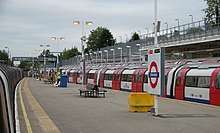
Nearby places
Tube/Trains
Stanmore has direct London Underground access to Central London via the Jubilee line.
Main bus routes
| Route | Start | End | Operator |
| 142 | Brent Cross | Watford Junction | Arriva Shires & Essex |
| 324 | Stanmore | Brent Cross | London Sovereign |
| 340 | Edgware | Harrow | Arriva Shires & Essex |
| H12 | Stanmore | South Harrow | Metroline |
| N98 | Stanmore | Holborn | Metroline |
| 107 | Edgware | New Barnet | Metroline |
| 186 | Brent Cross | Northwick Park Hospital | Metroline |
| 615 | Hatfield | Stanmore | Uno |
References
- "Harrow Ward population 2011". Neighbourhood Statistics. Office for National Statistics. Retrieved 24 October 2016.
- "Canons". UK Census Data. Retrieved 24 September 2017.
- Victoria County History, Middlesex, Harrow including Pinner, Manors, 1971
- H Bolitho and D Peel, The Drummonds of Charing Cross (London: George, Allen & Unwin, 1967)
- "Andrew Drummond, Stanmore Resident and founder of The London bank Messrs Drummond". www.stanmoretouristboard.org.uk. Archived from the original on 11 February 2018. Retrieved 11 February 2018.
- Baggs, A P; Bolton, Diane K; Scarff, Eileen P; Tyack, G C. "A History of the County of Middlesex: Volume 5, Hendon, Kingsbury, Great Stanmore, Little Stanmore, Edmonton Enfield, Monken Hadley, South Mimms, Tottenham". British History Online. British History Online. Retrieved 26 May 2020.
- "The Harrow and Stanmore railway". www.stanmoretouristboard.org.uk. The Stanmore Tourist Board. Archived from the original on 7 February 2018. Retrieved 7 February 2018.
- Stedman, Jane W. "Gilbert, Sir William Schwenck (1836–1911)", Oxford Dictionary of National Biography, Oxford University Press, September 2004, online edition, May 2008, accessed 10 January 2010 (subscription or UK public library membership required)
- "Stanmore - Hidden London". hidden-london.com. Retrieved 11 February 2018.
- Ellis, Mike (26 December 1996). "Notes about the Churches of Great Stanmore". Short History of Stanmore. Mike Ellis. Retrieved 15 January 2010.
- Archived 9 February 2012 at the Wayback Machine
- "Great Stanmore: Church". British History Online. Victoria County History. Retrieved 20 September 2016.
- T F T Baker, R B Pugh (Editors), A P Baggs, Diane K Bolton, Eileen P Scarff, G C Tyack (1976). "Great Stanmore: Church". A History of the County of Middlesex: Volume 5: Hendon, Kingsbury, Great Stanmore, Little Stanmore, Edmonton Enfield, Monken Hadley, South Mimms, Tottenham. Institute of Historical Research. Retrieved 3 April 2013.CS1 maint: multiple names: authors list (link)
- "Stanmore Synagogue Home Page". Sacps.org.uk. 12 January 1999. Retrieved 19 May 2014.
- "Hujjat.org". Hujjat.org. Retrieved 19 May 2014.
- "Portal of Swaminarayan". Swaminarayan Satsang. 19 January 2013. Retrieved 19 May 2014.
- "Stanmore Park". UK Census Data. Retrieved 24 September 2017.
- Great Stanmore: Introduction', A History of the County of Middlesex: Volume 5: Hendon, Kingsbury, Great Stanmore, Little Stanmore, Edmonton Enfield, Monken Hadley, South Mimms, Tottenham (1976), pp. 88–96. URL: Date accessed: 12 May 2009.
- Medina Cotten, Patricia (1998). Laid back in Hollywood: Remembering. Los Angeles: Belle Publishing. pp. 1–2. ISBN 0-9649635-2-3.
- "Theo Walcott". TheFA.com. Retrieved 19 May 2014.
- "Olly Mann is a presenter, columnist and technology commentator". ollymann.co.uk. Retrieved 30 November 2016.
External links
| Wikimedia Commons has media related to Stanmore. |

